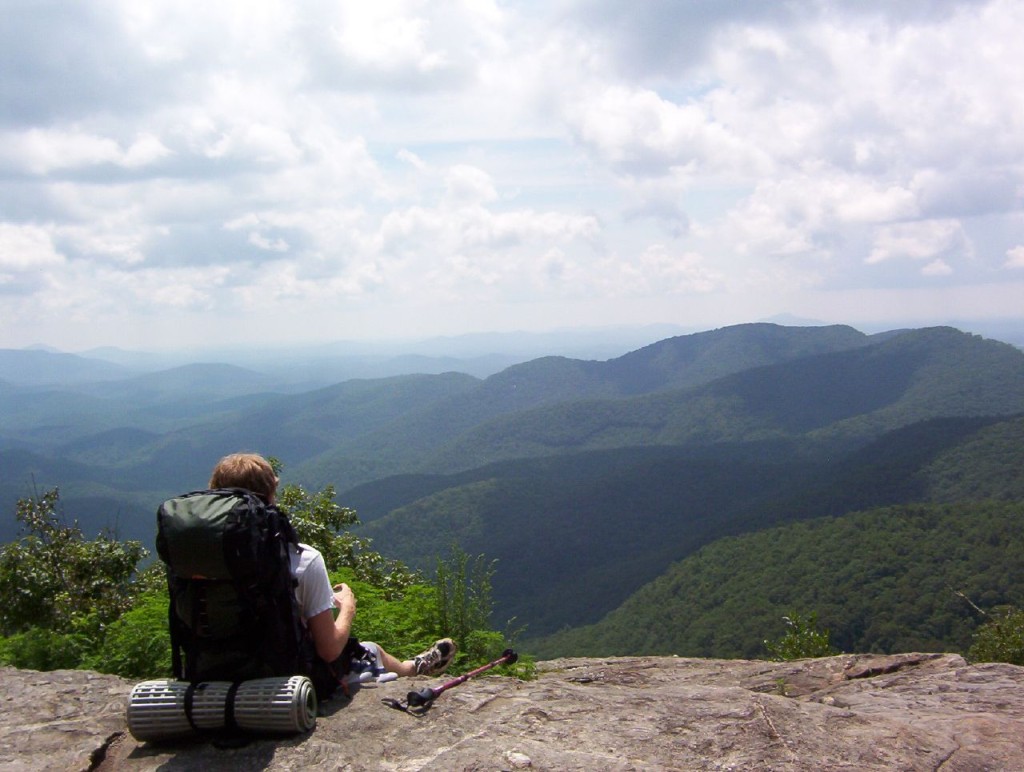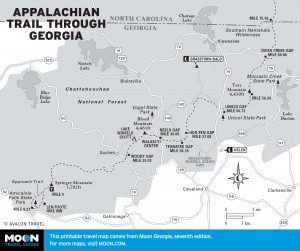
View from Granny Top Mountain. Photo © Matt Phillips, licensed Creative Commons Attribution.
Georgia’s section of the Appalachian Trail (AT) is 76 miles long from Springer Mountain to Bly Gap and on into North Carolina. At its highest point in Georgia, Blood Mountain, the AT is 4,460 feet above sea level; its low spot is Dicks Creek Gap at 2,675 feet. White rectangular blazes mark the trail, with turns being marked with double blazes. Many of the views are truly beautiful, but be aware that extensive logging occurred throughout the area and virtually no place was immune. Whole lifetimes are spent learning every inch of the AT, and many detailed volumes have been written about every foot of its length. Following is a brief overview of Georgia’s six sections of the Appalachian Trail.
Appalachian Trail Through Georgia
A bit north of the southern terminus is the Spring Mountain Shelter, a simple lean-to construction with two levels, room for about 10 hikers, and dependable drinking water. A bit farther north still is the right turn onto the Benton MacKaye Trail, which briefly follows an original route of the AT. Benton MacKaye rejoins the AT for about a half-mile along Rich Mountain and then splits off for good. The MacKaye Trail shares a stretch with the Duncan Ridge Trail, commonly considered one of the most challenging hikes in the United States (it breaks off at Georgia Highway 60 and will eventually circle around to end at a different point on the AT). At mile 4 you’ll hit Three Forks, a pretty area marking the confluence of Stover, Chester, and Long Creeks to form Noontootla Creek. The Appalachian Trail doesn’t begin to be really challenging until about mile 7, when you enter a more mountainous area of Lumpkin County. Several more brushes with Forest Service Road 42 bring you to Woody Gap and the crossing of Highway 60, the first of six times the AT crosses a road in Georgia. Camping shelters along this section include Stover Creek at mile 2.5, Hawk Mountain Shelter at mile 7.6, and Gooch Gap Shelter at mile 16.
This relatively short stretch features a lot of nice scenery and several intersections with other trails; therefore, you will rarely be alone for long on it. The first really nice spot is at Miller Gap, where you’ll get nice views of Blood Mountain, the highest the AT gets in Georgia and which you’ll be climbing soon enough. A little while longer takes you across the Slaughter Creek Trail, a popular trail from nearby Lake Winfield Scott. (The graphic place names in the area supposedly come from an epic clash between Indian tribes long ago.) From Slaughter Creek to the end of this section at Neels Gap is a no-campfire zone. A turn due east onto some rock steps marks the beginning of your relatively slow and easy ascent of Blood Mountain; as you climb, shortly you’ll come across the end of the Duncan Ridge Trail. At “Picnic Rock,” the summit of the mountain, you’ll see a little cottage built by the Civilian Conservation Corps (CCC), a relic from the time of the Great Depression that’s now on the National Register of Historic Places. A steep descent takes you down into Neels Gap (known to old-timers as Frogtown Gap) and the AT’s crossing of U.S. Highway 129 (Georgia 19).
This is where you’ll find a delightful and welcome oasis for hikers: the legendary Mountain Crossings at Walasi-yi. A combination rest stop and provisioning point in a CCC-built structure, it is adjacent to the site of an old Cherokee village and was originally intended as a traveler’s inn. However, parking at the Walasi-yi Center is for customers only, so don’t be tempted to park your car here to hike the AT. Walasi-yi boasts a distinctive wraparound porch and a small breezeway marked with a white blaze—the only point on the Georgia AT where you pass through a building. Some scholarship indicates that because of the existence of an ancient Cherokee path in its footsteps here, this could be the single oldest stretch of the Appalachian Trail.
The shortest section of the Georgia AT begins with a 1.5-mile climb of nearly 1,000 feet in elevation to Levelland Mountain, featuring some great views. A campsite is another 1.5 miles ahead. A descent to Tesnatee Gap takes the AT along the Richard B. Russell Scenic Highway for a very brief bit before the steep, strenuous ascent up Wildcat Mountain and down to Hogpen Gap and its attached parking area. At mile 6.2 you can take a side trail about a mile to Whitley Gap Shelter.
This mostly easy section of trail runs through Wolfpen Stamp and along Strawberry Top, Poor Mountain, and Sheep Rock Top and down to the well-known shelter at Low Gap (mile 4.2), a popular place for AT hikers to spend their first night on the trail. Whether or not you break here, the next eight miles is taken up with a jaunt up and along Blue Mountain (there’s a shelter at mile 11.4 of this section). At mile 9.2 of this section is the Chattahoochee Gap; look to your right and about 200 yards away you’ll see the small spring that is actually the headwaters of the Chattahoochee River. It’s somewhat surreal and daunting to realize the ‘Hooch is a major source of drinking water for the massive metro Atlanta area, and indeed a lot of AT hikers take a drink from its waters right here. Chattahoochee Gap is also the intersection with Jack’s Knob Trail, which takes you about 4.5 miles to the parking area at the summit of Brasstown Bald. A sharp descent from Blue Mountain takes you near the parking area at Unicoi Gap.
Starting at the Unicoi Gap parking area, this section climbs to the crown of Rocky Mountain at mile l.3. In a mile you’ll intersect with the Rocky Mountain Trail junction to the left. On top of Rocky Mountain, look to the right to see Yonah Mountain. The section descends to Forest Service Road 283 in Indian Grave Gap at mile 2.7. Across the road, the AT enters an evergreen tunnel and then goes upward to cross Tray Mountain Road at mile 3.3, continues 0.2 miles to the ridge top, then hits the site of the “old cheese factory,” a 19th-century farm. Tray Gap is next, on the way up to Tray’s Summit, the second-highest point of the AT in Georgia and home to some beautiful panoramic views. At mile 5.5, a spur trail leads to the Tray Mountain Shelter. After Tray Mountain comes the traverse of several more gap-and-ridge combos until mile 12.6 when you come down into Deep Gap, with the Deep Gap Shelter off a spur on the right. The next high point will be Powell Mountain and a 90-degree turn onto an old road, whereupon you finish a mile down to Dicks Creek Gap.
This final, busy stretch of the AT in Georgia is trickier than it may seem, with some shorter but steeper grades. From the picnic tables at Dicks Creek Gap you’ll make you way over the next mile to Little Bald Mountain and a series of up-down ridge climbs. At mile 8.4 you actually cross briefly into North Carolina before coming back into Georgia for a while, until ending at Bly Gap.
Excerpted from the Seventh Edition of Moon Georgia.